Comprehensive Financial Analysis and Performance of Tesco PLC
VerifiedAdded on 2021/04/19
|15
|4154
|498
Project
AI Summary
This project report provides a comprehensive financial analysis of Tesco PLC, examining its performance in the retail industry. The report begins with an introduction and company overview, highlighting Tesco's market position and recent developments, including the impact of the 2014 financial crisis and subsequent globalization and liberalization trends. It then delves into the financial performance of the company, using ratio analysis to evaluate profitability, liquidity, and efficiency over a two-year period. The analysis reveals a decline in profitability but improvements in liquidity. Furthermore, the report assesses Tesco's financial strategies, including its sources of finance, capital structure, and dividend policy, and their impact on financial performance. The report concludes that while the company faced challenges, strategic adjustments have helped manage risk and maintain a competitive position in the market. The report uses financial statements and annual reports to support its findings, offering a detailed evaluation of Tesco's financial health and strategic decisions. This report provides valuable insights into Tesco's financial strategies and their impact on the company's performance.
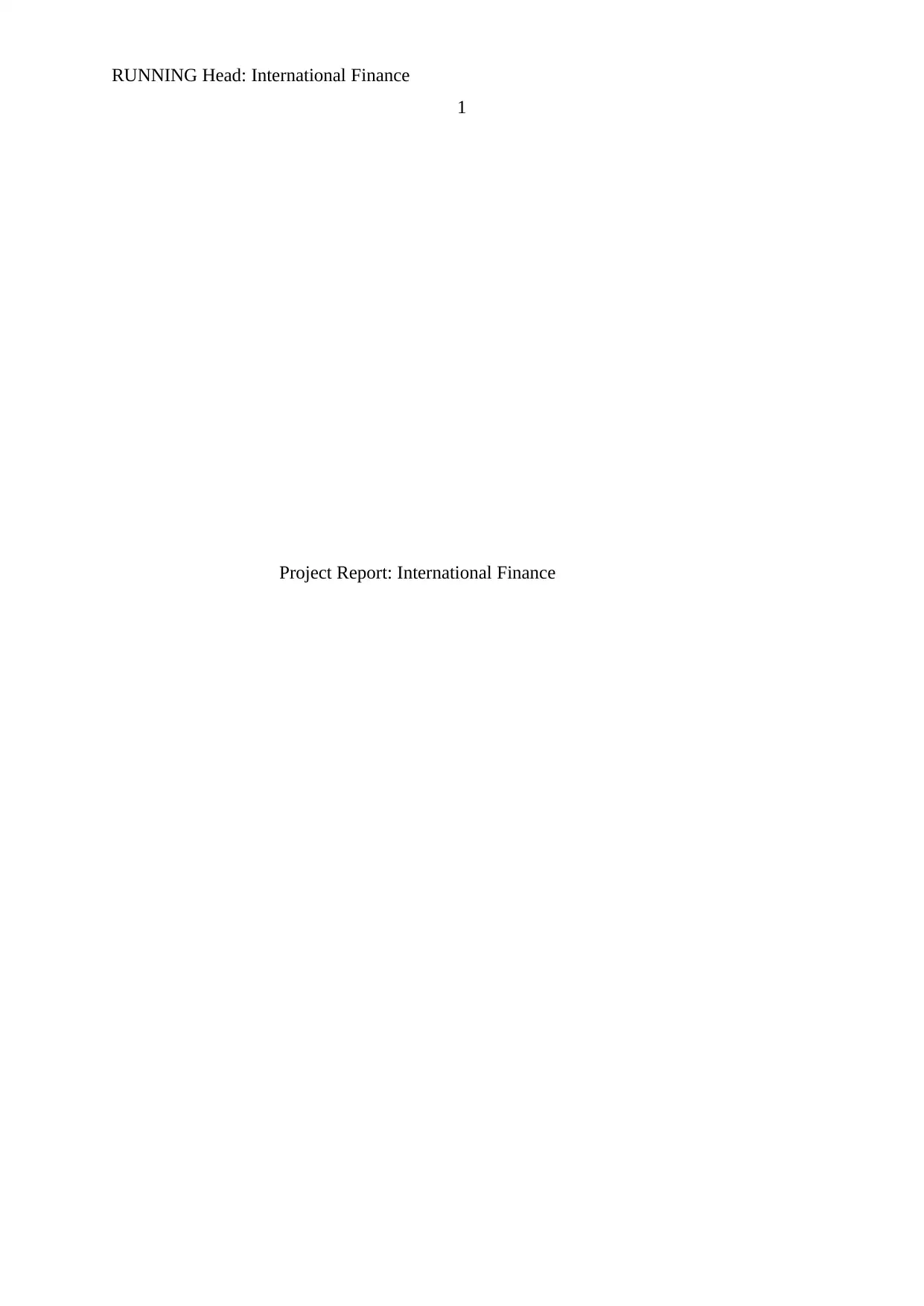
RUNNING Head: International Finance
1
Project Report: International Finance
1
Project Report: International Finance
Paraphrase This Document
Need a fresh take? Get an instant paraphrase of this document with our AI Paraphraser
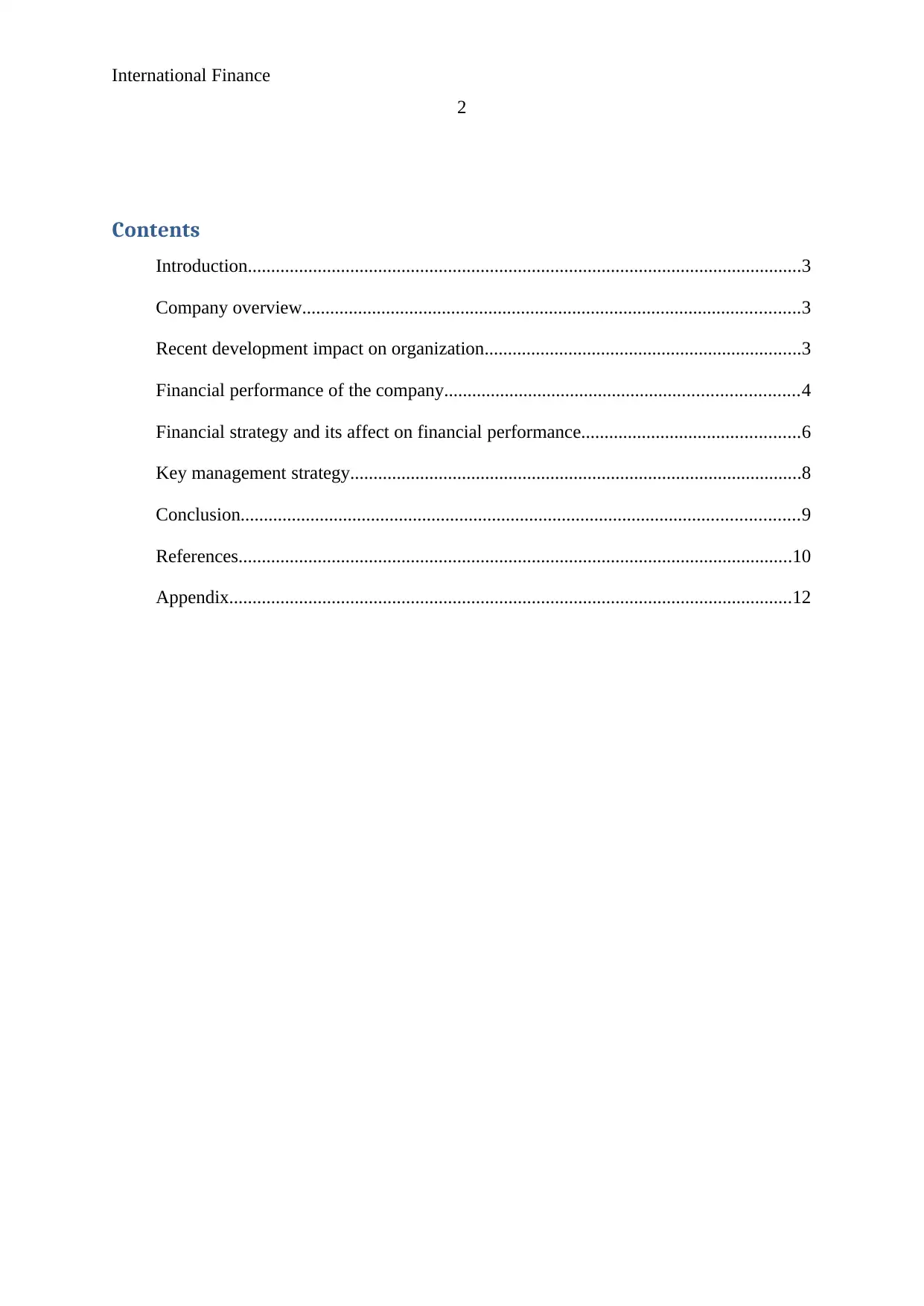
International Finance
2
Contents
Introduction.......................................................................................................................3
Company overview...........................................................................................................3
Recent development impact on organization....................................................................3
Financial performance of the company............................................................................4
Financial strategy and its affect on financial performance...............................................6
Key management strategy.................................................................................................8
Conclusion........................................................................................................................9
References.......................................................................................................................10
Appendix.........................................................................................................................12
2
Contents
Introduction.......................................................................................................................3
Company overview...........................................................................................................3
Recent development impact on organization....................................................................3
Financial performance of the company............................................................................4
Financial strategy and its affect on financial performance...............................................6
Key management strategy.................................................................................................8
Conclusion........................................................................................................................9
References.......................................................................................................................10
Appendix.........................................................................................................................12
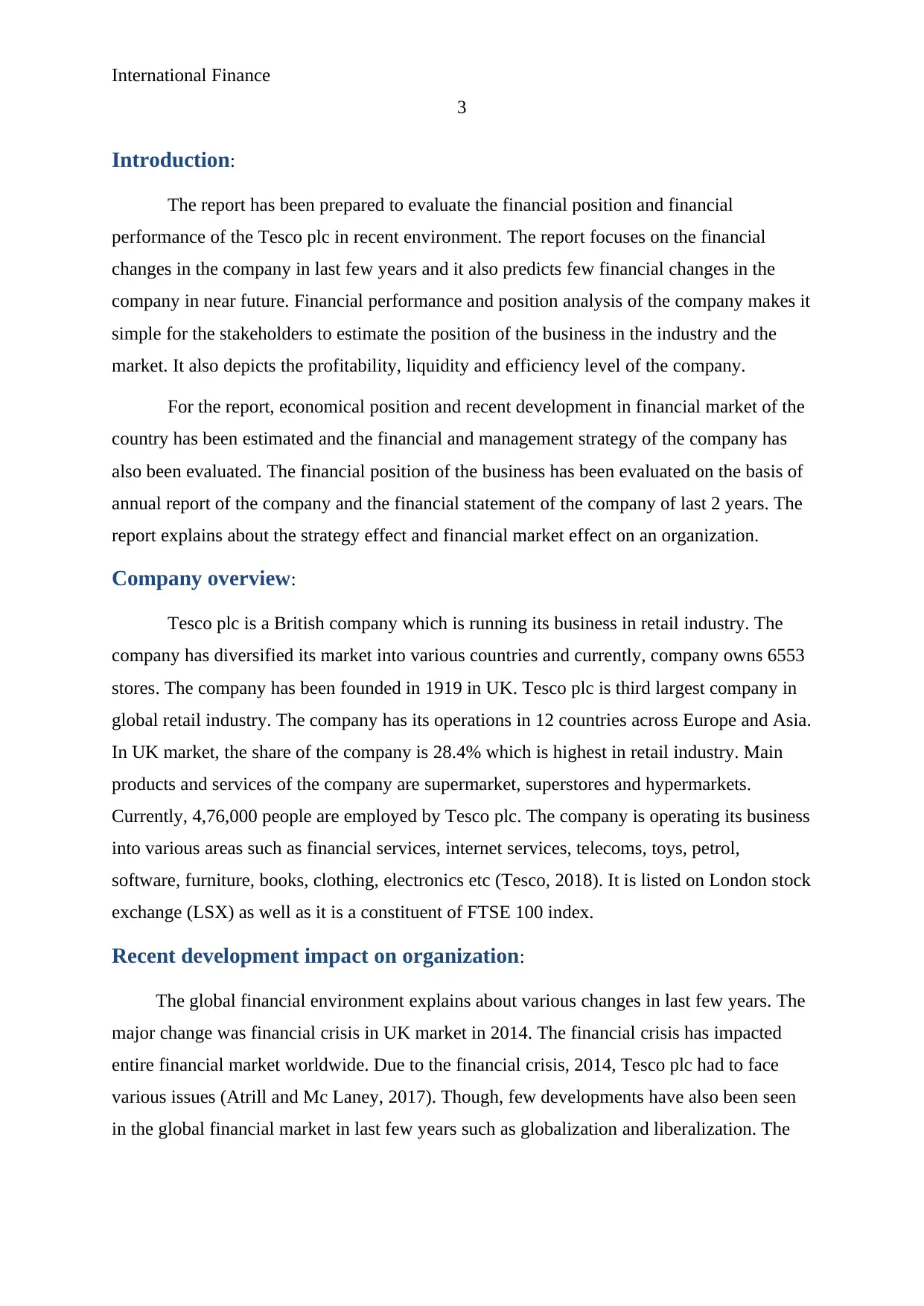
International Finance
3
Introduction:
The report has been prepared to evaluate the financial position and financial
performance of the Tesco plc in recent environment. The report focuses on the financial
changes in the company in last few years and it also predicts few financial changes in the
company in near future. Financial performance and position analysis of the company makes it
simple for the stakeholders to estimate the position of the business in the industry and the
market. It also depicts the profitability, liquidity and efficiency level of the company.
For the report, economical position and recent development in financial market of the
country has been estimated and the financial and management strategy of the company has
also been evaluated. The financial position of the business has been evaluated on the basis of
annual report of the company and the financial statement of the company of last 2 years. The
report explains about the strategy effect and financial market effect on an organization.
Company overview:
Tesco plc is a British company which is running its business in retail industry. The
company has diversified its market into various countries and currently, company owns 6553
stores. The company has been founded in 1919 in UK. Tesco plc is third largest company in
global retail industry. The company has its operations in 12 countries across Europe and Asia.
In UK market, the share of the company is 28.4% which is highest in retail industry. Main
products and services of the company are supermarket, superstores and hypermarkets.
Currently, 4,76,000 people are employed by Tesco plc. The company is operating its business
into various areas such as financial services, internet services, telecoms, toys, petrol,
software, furniture, books, clothing, electronics etc (Tesco, 2018). It is listed on London stock
exchange (LSX) as well as it is a constituent of FTSE 100 index.
Recent development impact on organization:
The global financial environment explains about various changes in last few years. The
major change was financial crisis in UK market in 2014. The financial crisis has impacted
entire financial market worldwide. Due to the financial crisis, 2014, Tesco plc had to face
various issues (Atrill and Mc Laney, 2017). Though, few developments have also been seen
in the global financial market in last few years such as globalization and liberalization. The
3
Introduction:
The report has been prepared to evaluate the financial position and financial
performance of the Tesco plc in recent environment. The report focuses on the financial
changes in the company in last few years and it also predicts few financial changes in the
company in near future. Financial performance and position analysis of the company makes it
simple for the stakeholders to estimate the position of the business in the industry and the
market. It also depicts the profitability, liquidity and efficiency level of the company.
For the report, economical position and recent development in financial market of the
country has been estimated and the financial and management strategy of the company has
also been evaluated. The financial position of the business has been evaluated on the basis of
annual report of the company and the financial statement of the company of last 2 years. The
report explains about the strategy effect and financial market effect on an organization.
Company overview:
Tesco plc is a British company which is running its business in retail industry. The
company has diversified its market into various countries and currently, company owns 6553
stores. The company has been founded in 1919 in UK. Tesco plc is third largest company in
global retail industry. The company has its operations in 12 countries across Europe and Asia.
In UK market, the share of the company is 28.4% which is highest in retail industry. Main
products and services of the company are supermarket, superstores and hypermarkets.
Currently, 4,76,000 people are employed by Tesco plc. The company is operating its business
into various areas such as financial services, internet services, telecoms, toys, petrol,
software, furniture, books, clothing, electronics etc (Tesco, 2018). It is listed on London stock
exchange (LSX) as well as it is a constituent of FTSE 100 index.
Recent development impact on organization:
The global financial environment explains about various changes in last few years. The
major change was financial crisis in UK market in 2014. The financial crisis has impacted
entire financial market worldwide. Due to the financial crisis, 2014, Tesco plc had to face
various issues (Atrill and Mc Laney, 2017). Though, few developments have also been seen
in the global financial market in last few years such as globalization and liberalization. The
⊘ This is a preview!⊘
Do you want full access?
Subscribe today to unlock all pages.

Trusted by 1+ million students worldwide
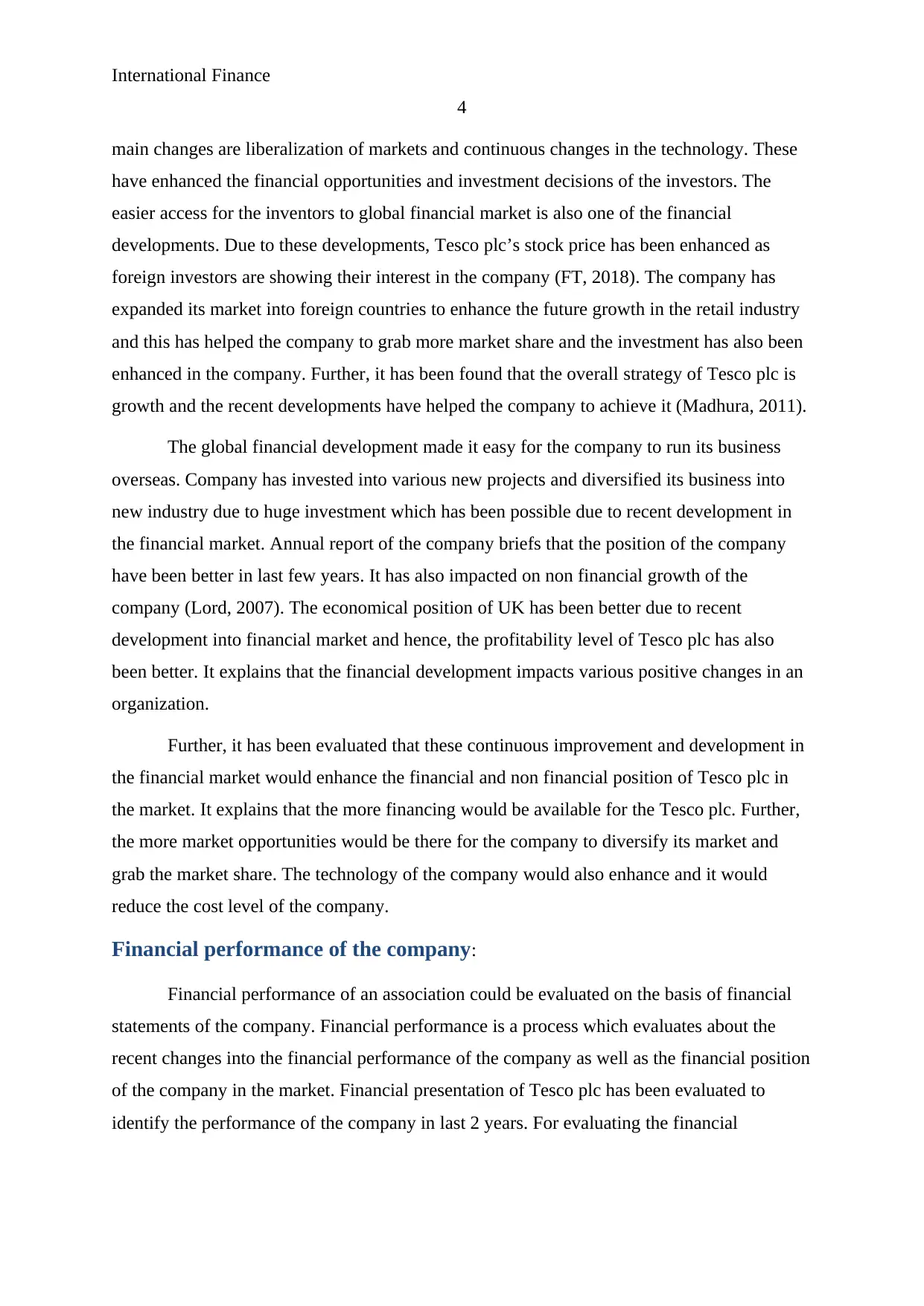
International Finance
4
main changes are liberalization of markets and continuous changes in the technology. These
have enhanced the financial opportunities and investment decisions of the investors. The
easier access for the inventors to global financial market is also one of the financial
developments. Due to these developments, Tesco plc’s stock price has been enhanced as
foreign investors are showing their interest in the company (FT, 2018). The company has
expanded its market into foreign countries to enhance the future growth in the retail industry
and this has helped the company to grab more market share and the investment has also been
enhanced in the company. Further, it has been found that the overall strategy of Tesco plc is
growth and the recent developments have helped the company to achieve it (Madhura, 2011).
The global financial development made it easy for the company to run its business
overseas. Company has invested into various new projects and diversified its business into
new industry due to huge investment which has been possible due to recent development in
the financial market. Annual report of the company briefs that the position of the company
have been better in last few years. It has also impacted on non financial growth of the
company (Lord, 2007). The economical position of UK has been better due to recent
development into financial market and hence, the profitability level of Tesco plc has also
been better. It explains that the financial development impacts various positive changes in an
organization.
Further, it has been evaluated that these continuous improvement and development in
the financial market would enhance the financial and non financial position of Tesco plc in
the market. It explains that the more financing would be available for the Tesco plc. Further,
the more market opportunities would be there for the company to diversify its market and
grab the market share. The technology of the company would also enhance and it would
reduce the cost level of the company.
Financial performance of the company:
Financial performance of an association could be evaluated on the basis of financial
statements of the company. Financial performance is a process which evaluates about the
recent changes into the financial performance of the company as well as the financial position
of the company in the market. Financial presentation of Tesco plc has been evaluated to
identify the performance of the company in last 2 years. For evaluating the financial
4
main changes are liberalization of markets and continuous changes in the technology. These
have enhanced the financial opportunities and investment decisions of the investors. The
easier access for the inventors to global financial market is also one of the financial
developments. Due to these developments, Tesco plc’s stock price has been enhanced as
foreign investors are showing their interest in the company (FT, 2018). The company has
expanded its market into foreign countries to enhance the future growth in the retail industry
and this has helped the company to grab more market share and the investment has also been
enhanced in the company. Further, it has been found that the overall strategy of Tesco plc is
growth and the recent developments have helped the company to achieve it (Madhura, 2011).
The global financial development made it easy for the company to run its business
overseas. Company has invested into various new projects and diversified its business into
new industry due to huge investment which has been possible due to recent development in
the financial market. Annual report of the company briefs that the position of the company
have been better in last few years. It has also impacted on non financial growth of the
company (Lord, 2007). The economical position of UK has been better due to recent
development into financial market and hence, the profitability level of Tesco plc has also
been better. It explains that the financial development impacts various positive changes in an
organization.
Further, it has been evaluated that these continuous improvement and development in
the financial market would enhance the financial and non financial position of Tesco plc in
the market. It explains that the more financing would be available for the Tesco plc. Further,
the more market opportunities would be there for the company to diversify its market and
grab the market share. The technology of the company would also enhance and it would
reduce the cost level of the company.
Financial performance of the company:
Financial performance of an association could be evaluated on the basis of financial
statements of the company. Financial performance is a process which evaluates about the
recent changes into the financial performance of the company as well as the financial position
of the company in the market. Financial presentation of Tesco plc has been evaluated to
identify the performance of the company in last 2 years. For evaluating the financial
Paraphrase This Document
Need a fresh take? Get an instant paraphrase of this document with our AI Paraphraser
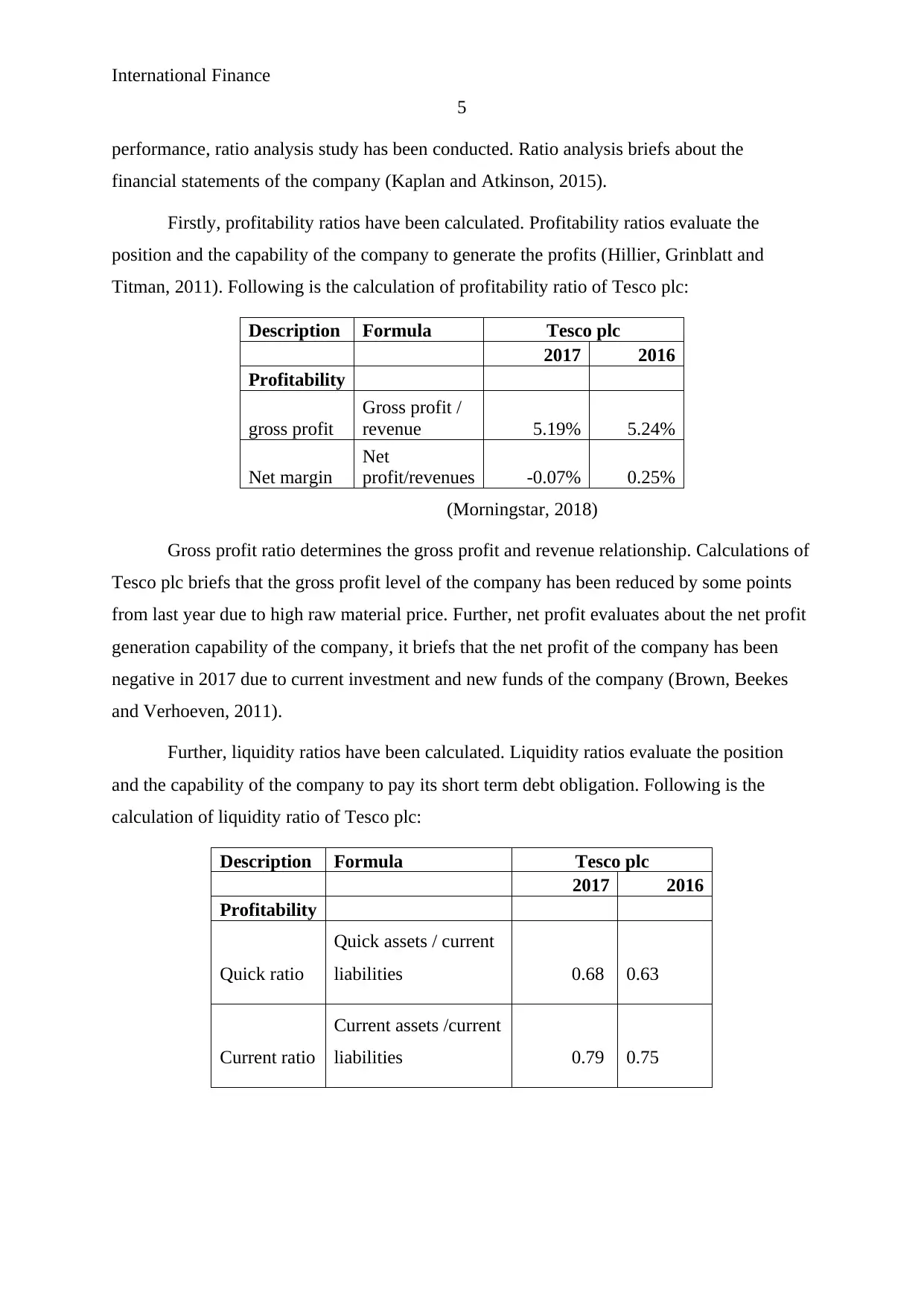
International Finance
5
performance, ratio analysis study has been conducted. Ratio analysis briefs about the
financial statements of the company (Kaplan and Atkinson, 2015).
Firstly, profitability ratios have been calculated. Profitability ratios evaluate the
position and the capability of the company to generate the profits (Hillier, Grinblatt and
Titman, 2011). Following is the calculation of profitability ratio of Tesco plc:
Description Formula Tesco plc
2017 2016
Profitability
gross profit
Gross profit /
revenue 5.19% 5.24%
Net margin
Net
profit/revenues -0.07% 0.25%
(Morningstar, 2018)
Gross profit ratio determines the gross profit and revenue relationship. Calculations of
Tesco plc briefs that the gross profit level of the company has been reduced by some points
from last year due to high raw material price. Further, net profit evaluates about the net profit
generation capability of the company, it briefs that the net profit of the company has been
negative in 2017 due to current investment and new funds of the company (Brown, Beekes
and Verhoeven, 2011).
Further, liquidity ratios have been calculated. Liquidity ratios evaluate the position
and the capability of the company to pay its short term debt obligation. Following is the
calculation of liquidity ratio of Tesco plc:
Description Formula Tesco plc
2017 2016
Profitability
Quick ratio
Quick assets / current
liabilities 0.68 0.63
Current ratio
Current assets /current
liabilities 0.79 0.75
5
performance, ratio analysis study has been conducted. Ratio analysis briefs about the
financial statements of the company (Kaplan and Atkinson, 2015).
Firstly, profitability ratios have been calculated. Profitability ratios evaluate the
position and the capability of the company to generate the profits (Hillier, Grinblatt and
Titman, 2011). Following is the calculation of profitability ratio of Tesco plc:
Description Formula Tesco plc
2017 2016
Profitability
gross profit
Gross profit /
revenue 5.19% 5.24%
Net margin
Net
profit/revenues -0.07% 0.25%
(Morningstar, 2018)
Gross profit ratio determines the gross profit and revenue relationship. Calculations of
Tesco plc briefs that the gross profit level of the company has been reduced by some points
from last year due to high raw material price. Further, net profit evaluates about the net profit
generation capability of the company, it briefs that the net profit of the company has been
negative in 2017 due to current investment and new funds of the company (Brown, Beekes
and Verhoeven, 2011).
Further, liquidity ratios have been calculated. Liquidity ratios evaluate the position
and the capability of the company to pay its short term debt obligation. Following is the
calculation of liquidity ratio of Tesco plc:
Description Formula Tesco plc
2017 2016
Profitability
Quick ratio
Quick assets / current
liabilities 0.68 0.63
Current ratio
Current assets /current
liabilities 0.79 0.75
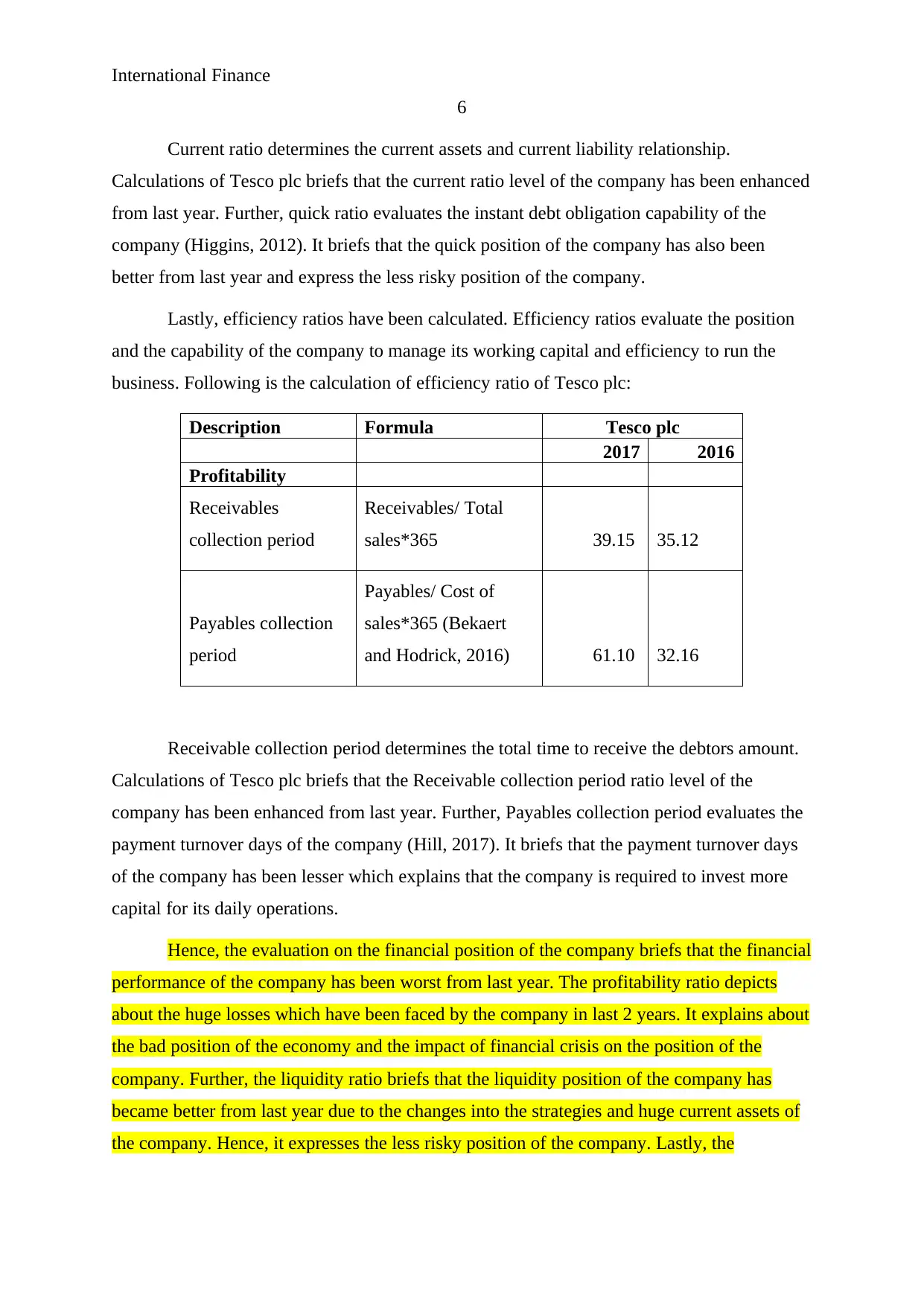
International Finance
6
Current ratio determines the current assets and current liability relationship.
Calculations of Tesco plc briefs that the current ratio level of the company has been enhanced
from last year. Further, quick ratio evaluates the instant debt obligation capability of the
company (Higgins, 2012). It briefs that the quick position of the company has also been
better from last year and express the less risky position of the company.
Lastly, efficiency ratios have been calculated. Efficiency ratios evaluate the position
and the capability of the company to manage its working capital and efficiency to run the
business. Following is the calculation of efficiency ratio of Tesco plc:
Description Formula Tesco plc
2017 2016
Profitability
Receivables
collection period
Receivables/ Total
sales*365 39.15 35.12
Payables collection
period
Payables/ Cost of
sales*365 (Bekaert
and Hodrick, 2016) 61.10 32.16
Receivable collection period determines the total time to receive the debtors amount.
Calculations of Tesco plc briefs that the Receivable collection period ratio level of the
company has been enhanced from last year. Further, Payables collection period evaluates the
payment turnover days of the company (Hill, 2017). It briefs that the payment turnover days
of the company has been lesser which explains that the company is required to invest more
capital for its daily operations.
Hence, the evaluation on the financial position of the company briefs that the financial
performance of the company has been worst from last year. The profitability ratio depicts
about the huge losses which have been faced by the company in last 2 years. It explains about
the bad position of the economy and the impact of financial crisis on the position of the
company. Further, the liquidity ratio briefs that the liquidity position of the company has
became better from last year due to the changes into the strategies and huge current assets of
the company. Hence, it expresses the less risky position of the company. Lastly, the
6
Current ratio determines the current assets and current liability relationship.
Calculations of Tesco plc briefs that the current ratio level of the company has been enhanced
from last year. Further, quick ratio evaluates the instant debt obligation capability of the
company (Higgins, 2012). It briefs that the quick position of the company has also been
better from last year and express the less risky position of the company.
Lastly, efficiency ratios have been calculated. Efficiency ratios evaluate the position
and the capability of the company to manage its working capital and efficiency to run the
business. Following is the calculation of efficiency ratio of Tesco plc:
Description Formula Tesco plc
2017 2016
Profitability
Receivables
collection period
Receivables/ Total
sales*365 39.15 35.12
Payables collection
period
Payables/ Cost of
sales*365 (Bekaert
and Hodrick, 2016) 61.10 32.16
Receivable collection period determines the total time to receive the debtors amount.
Calculations of Tesco plc briefs that the Receivable collection period ratio level of the
company has been enhanced from last year. Further, Payables collection period evaluates the
payment turnover days of the company (Hill, 2017). It briefs that the payment turnover days
of the company has been lesser which explains that the company is required to invest more
capital for its daily operations.
Hence, the evaluation on the financial position of the company briefs that the financial
performance of the company has been worst from last year. The profitability ratio depicts
about the huge losses which have been faced by the company in last 2 years. It explains about
the bad position of the economy and the impact of financial crisis on the position of the
company. Further, the liquidity ratio briefs that the liquidity position of the company has
became better from last year due to the changes into the strategies and huge current assets of
the company. Hence, it expresses the less risky position of the company. Lastly, the
⊘ This is a preview!⊘
Do you want full access?
Subscribe today to unlock all pages.

Trusted by 1+ million students worldwide
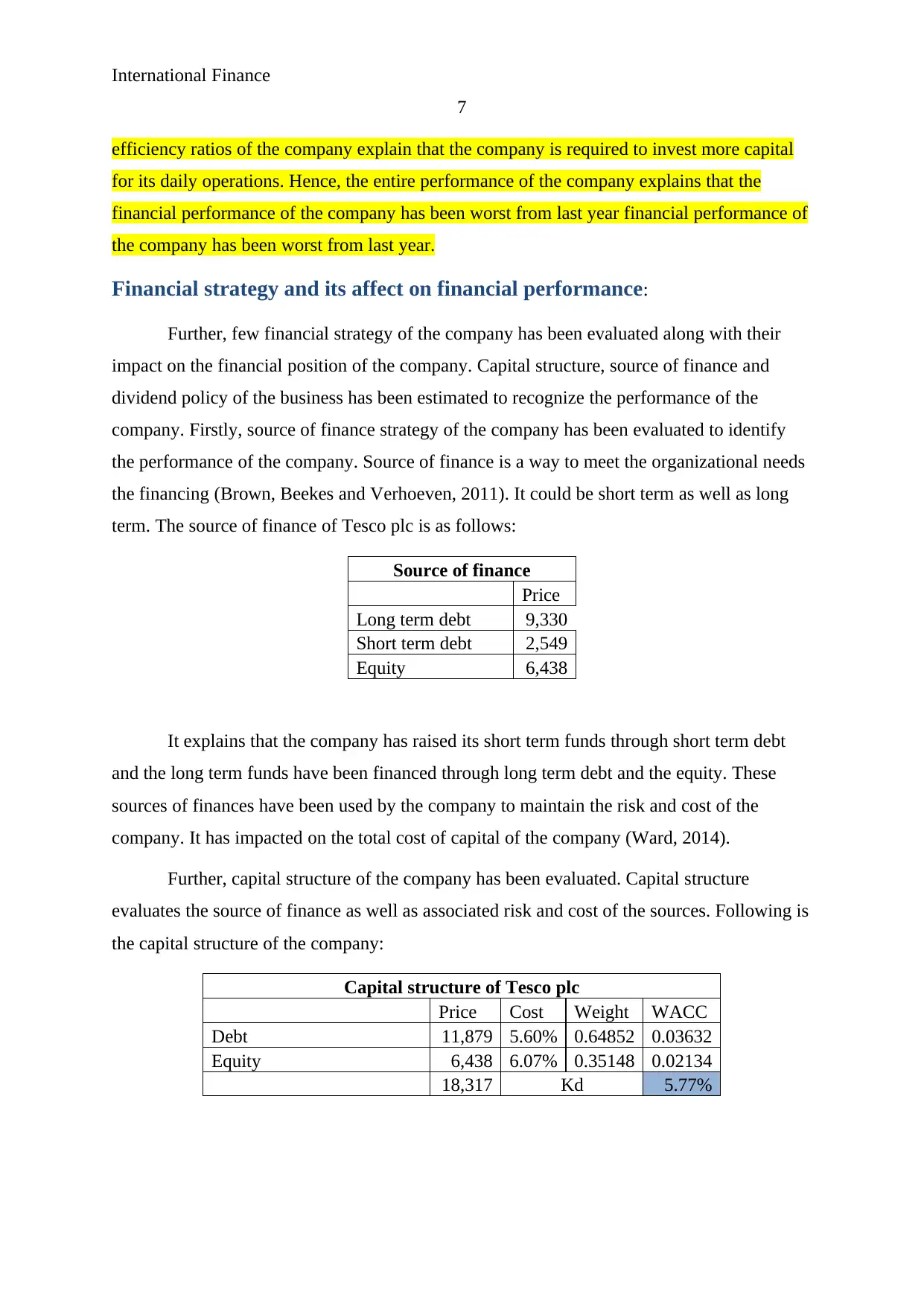
International Finance
7
efficiency ratios of the company explain that the company is required to invest more capital
for its daily operations. Hence, the entire performance of the company explains that the
financial performance of the company has been worst from last year financial performance of
the company has been worst from last year.
Financial strategy and its affect on financial performance:
Further, few financial strategy of the company has been evaluated along with their
impact on the financial position of the company. Capital structure, source of finance and
dividend policy of the business has been estimated to recognize the performance of the
company. Firstly, source of finance strategy of the company has been evaluated to identify
the performance of the company. Source of finance is a way to meet the organizational needs
the financing (Brown, Beekes and Verhoeven, 2011). It could be short term as well as long
term. The source of finance of Tesco plc is as follows:
Source of finance
Price
Long term debt 9,330
Short term debt 2,549
Equity 6,438
It explains that the company has raised its short term funds through short term debt
and the long term funds have been financed through long term debt and the equity. These
sources of finances have been used by the company to maintain the risk and cost of the
company. It has impacted on the total cost of capital of the company (Ward, 2014).
Further, capital structure of the company has been evaluated. Capital structure
evaluates the source of finance as well as associated risk and cost of the sources. Following is
the capital structure of the company:
Capital structure of Tesco plc
Price Cost Weight WACC
Debt 11,879 5.60% 0.64852 0.03632
Equity 6,438 6.07% 0.35148 0.02134
18,317 Kd 5.77%
7
efficiency ratios of the company explain that the company is required to invest more capital
for its daily operations. Hence, the entire performance of the company explains that the
financial performance of the company has been worst from last year financial performance of
the company has been worst from last year.
Financial strategy and its affect on financial performance:
Further, few financial strategy of the company has been evaluated along with their
impact on the financial position of the company. Capital structure, source of finance and
dividend policy of the business has been estimated to recognize the performance of the
company. Firstly, source of finance strategy of the company has been evaluated to identify
the performance of the company. Source of finance is a way to meet the organizational needs
the financing (Brown, Beekes and Verhoeven, 2011). It could be short term as well as long
term. The source of finance of Tesco plc is as follows:
Source of finance
Price
Long term debt 9,330
Short term debt 2,549
Equity 6,438
It explains that the company has raised its short term funds through short term debt
and the long term funds have been financed through long term debt and the equity. These
sources of finances have been used by the company to maintain the risk and cost of the
company. It has impacted on the total cost of capital of the company (Ward, 2014).
Further, capital structure of the company has been evaluated. Capital structure
evaluates the source of finance as well as associated risk and cost of the sources. Following is
the capital structure of the company:
Capital structure of Tesco plc
Price Cost Weight WACC
Debt 11,879 5.60% 0.64852 0.03632
Equity 6,438 6.07% 0.35148 0.02134
18,317 Kd 5.77%
Paraphrase This Document
Need a fresh take? Get an instant paraphrase of this document with our AI Paraphraser
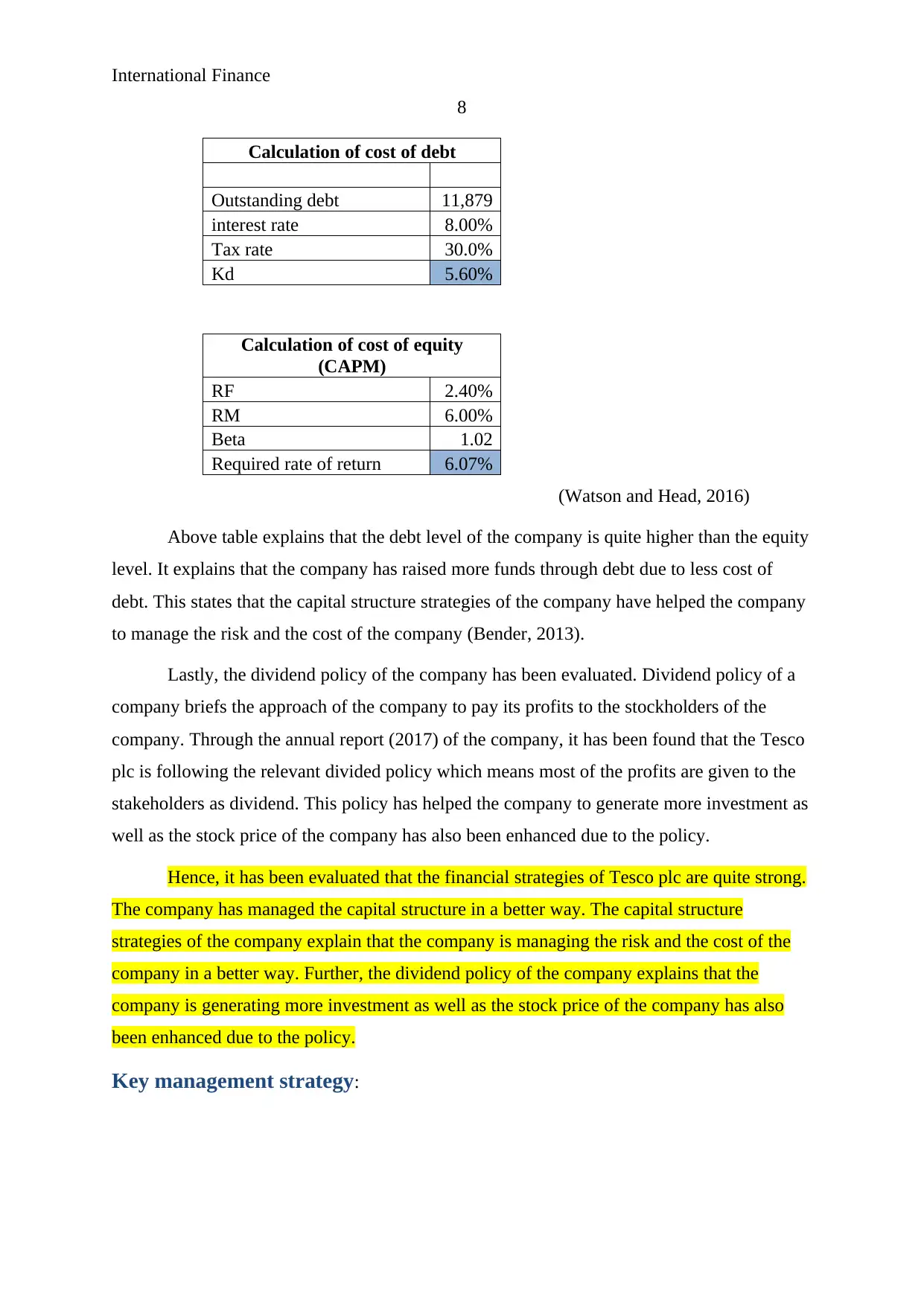
International Finance
8
Calculation of cost of debt
Outstanding debt 11,879
interest rate 8.00%
Tax rate 30.0%
Kd 5.60%
Calculation of cost of equity
(CAPM)
RF 2.40%
RM 6.00%
Beta 1.02
Required rate of return 6.07%
(Watson and Head, 2016)
Above table explains that the debt level of the company is quite higher than the equity
level. It explains that the company has raised more funds through debt due to less cost of
debt. This states that the capital structure strategies of the company have helped the company
to manage the risk and the cost of the company (Bender, 2013).
Lastly, the dividend policy of the company has been evaluated. Dividend policy of a
company briefs the approach of the company to pay its profits to the stockholders of the
company. Through the annual report (2017) of the company, it has been found that the Tesco
plc is following the relevant divided policy which means most of the profits are given to the
stakeholders as dividend. This policy has helped the company to generate more investment as
well as the stock price of the company has also been enhanced due to the policy.
Hence, it has been evaluated that the financial strategies of Tesco plc are quite strong.
The company has managed the capital structure in a better way. The capital structure
strategies of the company explain that the company is managing the risk and the cost of the
company in a better way. Further, the dividend policy of the company explains that the
company is generating more investment as well as the stock price of the company has also
been enhanced due to the policy.
Key management strategy:
8
Calculation of cost of debt
Outstanding debt 11,879
interest rate 8.00%
Tax rate 30.0%
Kd 5.60%
Calculation of cost of equity
(CAPM)
RF 2.40%
RM 6.00%
Beta 1.02
Required rate of return 6.07%
(Watson and Head, 2016)
Above table explains that the debt level of the company is quite higher than the equity
level. It explains that the company has raised more funds through debt due to less cost of
debt. This states that the capital structure strategies of the company have helped the company
to manage the risk and the cost of the company (Bender, 2013).
Lastly, the dividend policy of the company has been evaluated. Dividend policy of a
company briefs the approach of the company to pay its profits to the stockholders of the
company. Through the annual report (2017) of the company, it has been found that the Tesco
plc is following the relevant divided policy which means most of the profits are given to the
stakeholders as dividend. This policy has helped the company to generate more investment as
well as the stock price of the company has also been enhanced due to the policy.
Hence, it has been evaluated that the financial strategies of Tesco plc are quite strong.
The company has managed the capital structure in a better way. The capital structure
strategies of the company explain that the company is managing the risk and the cost of the
company in a better way. Further, the dividend policy of the company explains that the
company is generating more investment as well as the stock price of the company has also
been enhanced due to the policy.
Key management strategy:
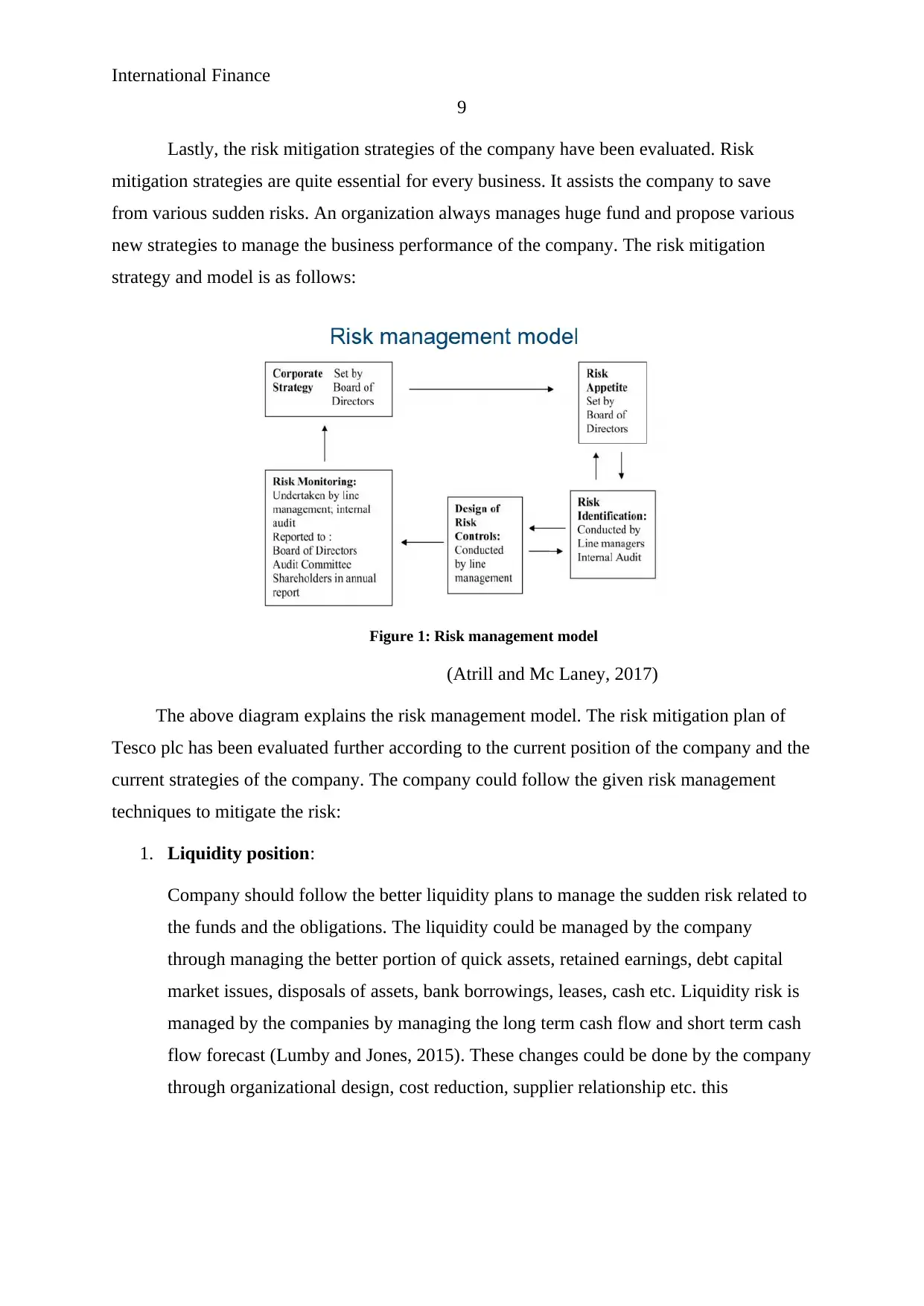
International Finance
9
Lastly, the risk mitigation strategies of the company have been evaluated. Risk
mitigation strategies are quite essential for every business. It assists the company to save
from various sudden risks. An organization always manages huge fund and propose various
new strategies to manage the business performance of the company. The risk mitigation
strategy and model is as follows:
Figure 1: Risk management model
(Atrill and Mc Laney, 2017)
The above diagram explains the risk management model. The risk mitigation plan of
Tesco plc has been evaluated further according to the current position of the company and the
current strategies of the company. The company could follow the given risk management
techniques to mitigate the risk:
1. Liquidity position:
Company should follow the better liquidity plans to manage the sudden risk related to
the funds and the obligations. The liquidity could be managed by the company
through managing the better portion of quick assets, retained earnings, debt capital
market issues, disposals of assets, bank borrowings, leases, cash etc. Liquidity risk is
managed by the companies by managing the long term cash flow and short term cash
flow forecast (Lumby and Jones, 2015). These changes could be done by the company
through organizational design, cost reduction, supplier relationship etc. this
9
Lastly, the risk mitigation strategies of the company have been evaluated. Risk
mitigation strategies are quite essential for every business. It assists the company to save
from various sudden risks. An organization always manages huge fund and propose various
new strategies to manage the business performance of the company. The risk mitigation
strategy and model is as follows:
Figure 1: Risk management model
(Atrill and Mc Laney, 2017)
The above diagram explains the risk management model. The risk mitigation plan of
Tesco plc has been evaluated further according to the current position of the company and the
current strategies of the company. The company could follow the given risk management
techniques to mitigate the risk:
1. Liquidity position:
Company should follow the better liquidity plans to manage the sudden risk related to
the funds and the obligations. The liquidity could be managed by the company
through managing the better portion of quick assets, retained earnings, debt capital
market issues, disposals of assets, bank borrowings, leases, cash etc. Liquidity risk is
managed by the companies by managing the long term cash flow and short term cash
flow forecast (Lumby and Jones, 2015). These changes could be done by the company
through organizational design, cost reduction, supplier relationship etc. this
⊘ This is a preview!⊘
Do you want full access?
Subscribe today to unlock all pages.

Trusted by 1+ million students worldwide
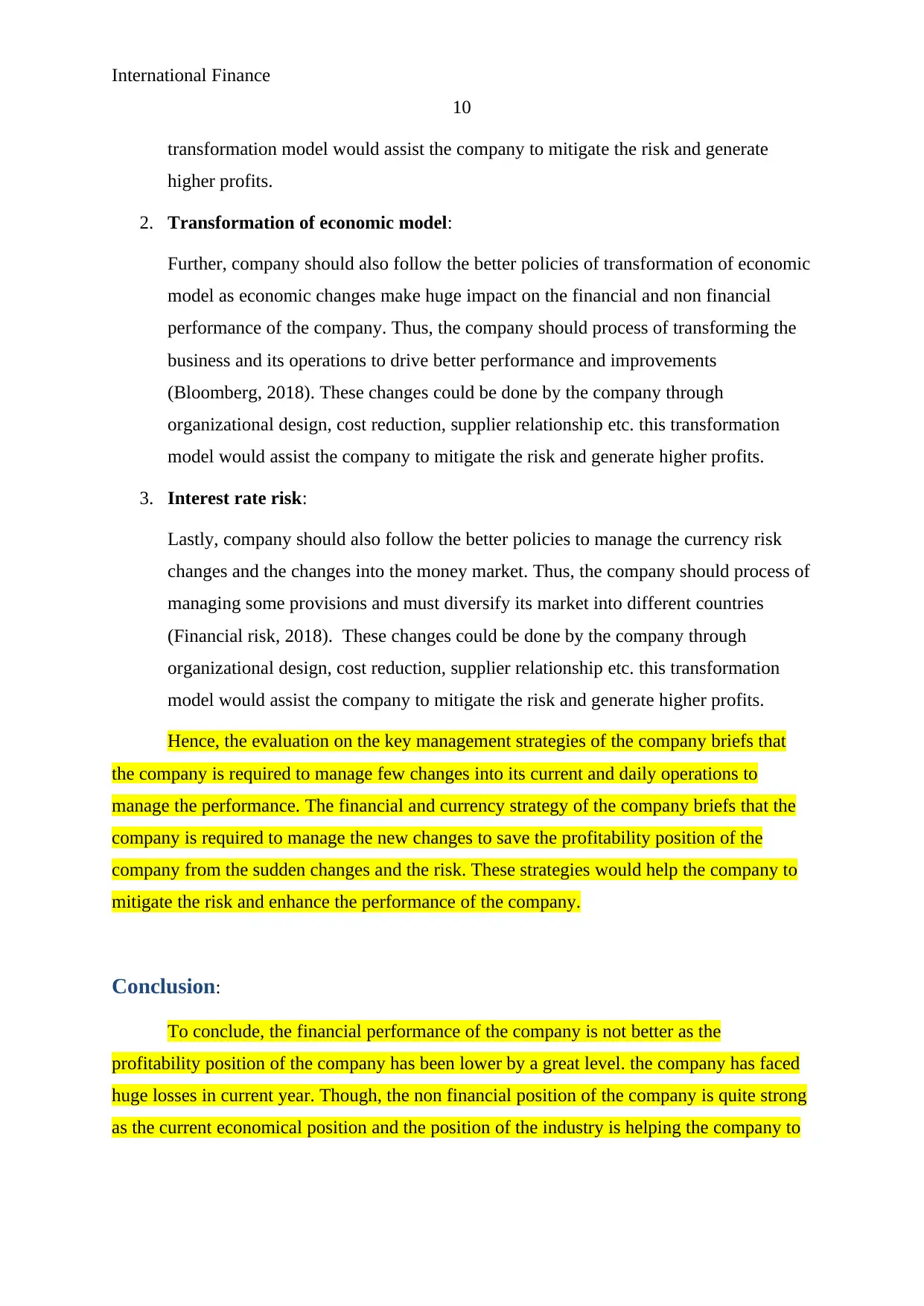
International Finance
10
transformation model would assist the company to mitigate the risk and generate
higher profits.
2. Transformation of economic model:
Further, company should also follow the better policies of transformation of economic
model as economic changes make huge impact on the financial and non financial
performance of the company. Thus, the company should process of transforming the
business and its operations to drive better performance and improvements
(Bloomberg, 2018). These changes could be done by the company through
organizational design, cost reduction, supplier relationship etc. this transformation
model would assist the company to mitigate the risk and generate higher profits.
3. Interest rate risk:
Lastly, company should also follow the better policies to manage the currency risk
changes and the changes into the money market. Thus, the company should process of
managing some provisions and must diversify its market into different countries
(Financial risk, 2018). These changes could be done by the company through
organizational design, cost reduction, supplier relationship etc. this transformation
model would assist the company to mitigate the risk and generate higher profits.
Hence, the evaluation on the key management strategies of the company briefs that
the company is required to manage few changes into its current and daily operations to
manage the performance. The financial and currency strategy of the company briefs that the
company is required to manage the new changes to save the profitability position of the
company from the sudden changes and the risk. These strategies would help the company to
mitigate the risk and enhance the performance of the company.
Conclusion:
To conclude, the financial performance of the company is not better as the
profitability position of the company has been lower by a great level. the company has faced
huge losses in current year. Though, the non financial position of the company is quite strong
as the current economical position and the position of the industry is helping the company to
10
transformation model would assist the company to mitigate the risk and generate
higher profits.
2. Transformation of economic model:
Further, company should also follow the better policies of transformation of economic
model as economic changes make huge impact on the financial and non financial
performance of the company. Thus, the company should process of transforming the
business and its operations to drive better performance and improvements
(Bloomberg, 2018). These changes could be done by the company through
organizational design, cost reduction, supplier relationship etc. this transformation
model would assist the company to mitigate the risk and generate higher profits.
3. Interest rate risk:
Lastly, company should also follow the better policies to manage the currency risk
changes and the changes into the money market. Thus, the company should process of
managing some provisions and must diversify its market into different countries
(Financial risk, 2018). These changes could be done by the company through
organizational design, cost reduction, supplier relationship etc. this transformation
model would assist the company to mitigate the risk and generate higher profits.
Hence, the evaluation on the key management strategies of the company briefs that
the company is required to manage few changes into its current and daily operations to
manage the performance. The financial and currency strategy of the company briefs that the
company is required to manage the new changes to save the profitability position of the
company from the sudden changes and the risk. These strategies would help the company to
mitigate the risk and enhance the performance of the company.
Conclusion:
To conclude, the financial performance of the company is not better as the
profitability position of the company has been lower by a great level. the company has faced
huge losses in current year. Though, the non financial position of the company is quite strong
as the current economical position and the position of the industry is helping the company to
Paraphrase This Document
Need a fresh take? Get an instant paraphrase of this document with our AI Paraphraser
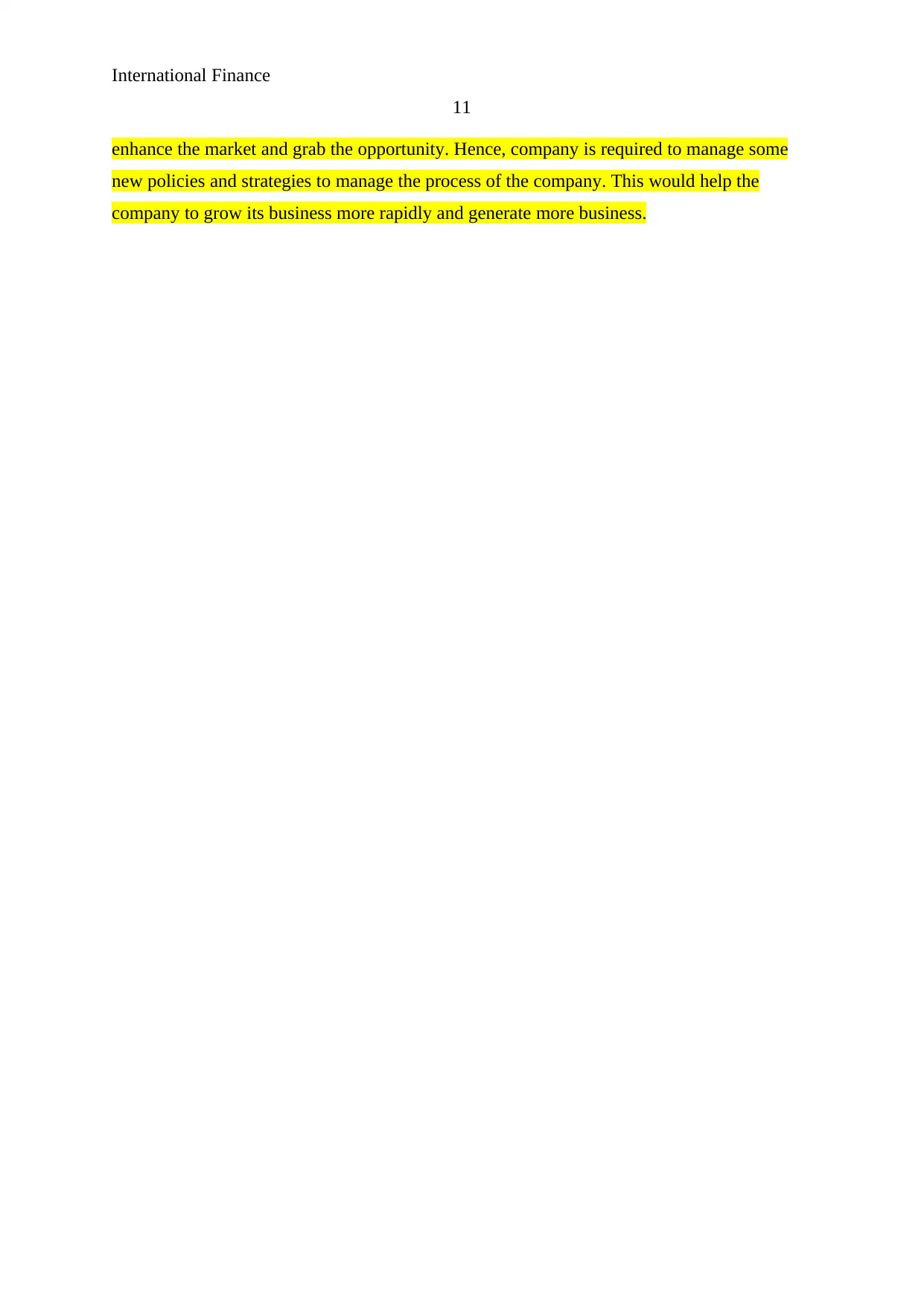
International Finance
11
enhance the market and grab the opportunity. Hence, company is required to manage some
new policies and strategies to manage the process of the company. This would help the
company to grow its business more rapidly and generate more business.
11
enhance the market and grab the opportunity. Hence, company is required to manage some
new policies and strategies to manage the process of the company. This would help the
company to grow its business more rapidly and generate more business.
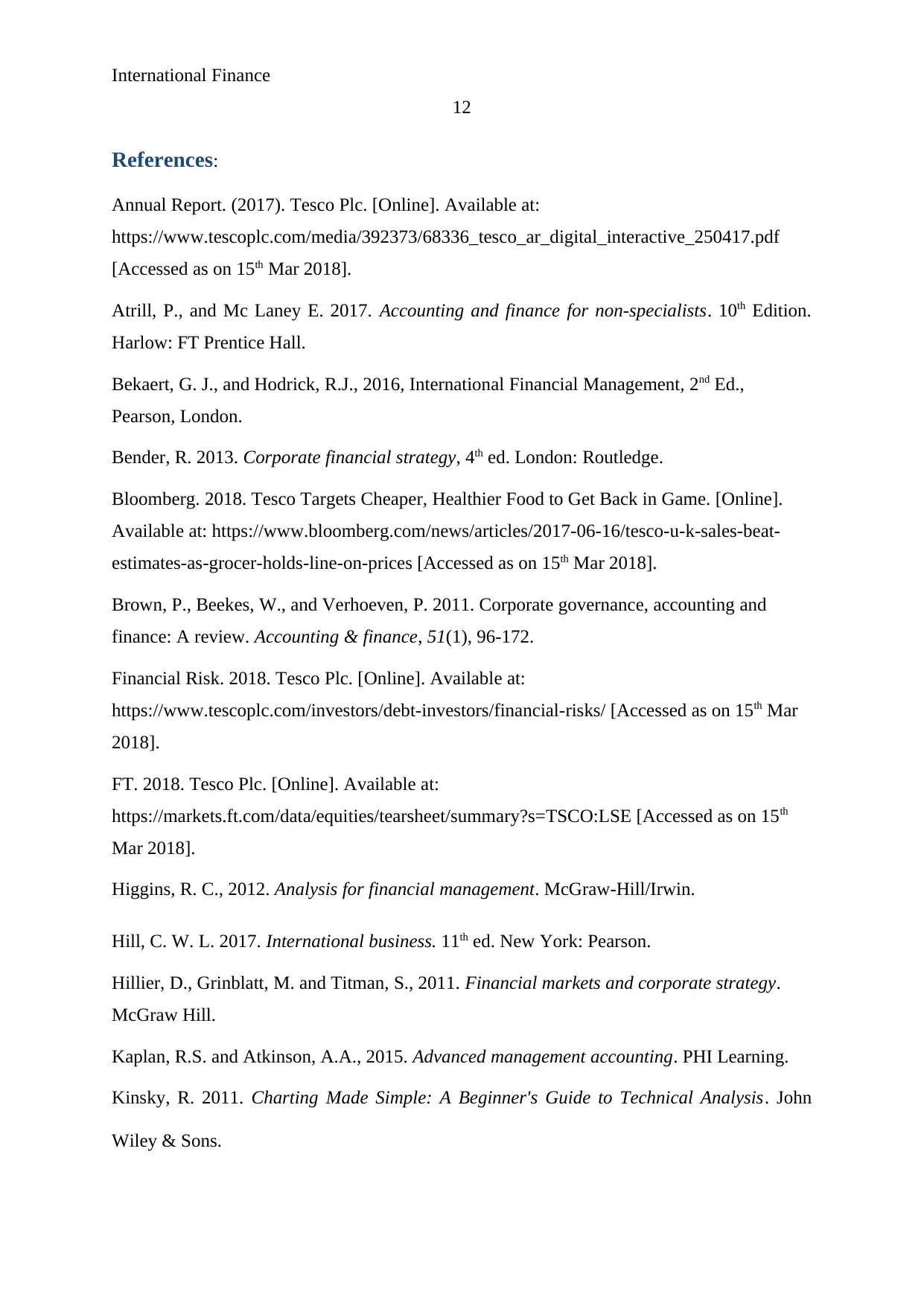
International Finance
12
References:
Annual Report. (2017). Tesco Plc. [Online]. Available at:
https://www.tescoplc.com/media/392373/68336_tesco_ar_digital_interactive_250417.pdf
[Accessed as on 15th Mar 2018].
Atrill, P., and Mc Laney E. 2017. Accounting and finance for non-specialists. 10th Edition.
Harlow: FT Prentice Hall.
Bekaert, G. J., and Hodrick, R.J., 2016, International Financial Management, 2nd Ed.,
Pearson, London.
Bender, R. 2013. Corporate financial strategy, 4th ed. London: Routledge.
Bloomberg. 2018. Tesco Targets Cheaper, Healthier Food to Get Back in Game. [Online].
Available at: https://www.bloomberg.com/news/articles/2017-06-16/tesco-u-k-sales-beat-
estimates-as-grocer-holds-line-on-prices [Accessed as on 15th Mar 2018].
Brown, P., Beekes, W., and Verhoeven, P. 2011. Corporate governance, accounting and
finance: A review. Accounting & finance, 51(1), 96-172.
Financial Risk. 2018. Tesco Plc. [Online]. Available at:
https://www.tescoplc.com/investors/debt-investors/financial-risks/ [Accessed as on 15th Mar
2018].
FT. 2018. Tesco Plc. [Online]. Available at:
https://markets.ft.com/data/equities/tearsheet/summary?s=TSCO:LSE [Accessed as on 15th
Mar 2018].
Higgins, R. C., 2012. Analysis for financial management. McGraw-Hill/Irwin.
Hill, C. W. L. 2017. International business. 11th ed. New York: Pearson.
Hillier, D., Grinblatt, M. and Titman, S., 2011. Financial markets and corporate strategy.
McGraw Hill.
Kaplan, R.S. and Atkinson, A.A., 2015. Advanced management accounting. PHI Learning.
Kinsky, R. 2011. Charting Made Simple: A Beginner's Guide to Technical Analysis. John
Wiley & Sons.
12
References:
Annual Report. (2017). Tesco Plc. [Online]. Available at:
https://www.tescoplc.com/media/392373/68336_tesco_ar_digital_interactive_250417.pdf
[Accessed as on 15th Mar 2018].
Atrill, P., and Mc Laney E. 2017. Accounting and finance for non-specialists. 10th Edition.
Harlow: FT Prentice Hall.
Bekaert, G. J., and Hodrick, R.J., 2016, International Financial Management, 2nd Ed.,
Pearson, London.
Bender, R. 2013. Corporate financial strategy, 4th ed. London: Routledge.
Bloomberg. 2018. Tesco Targets Cheaper, Healthier Food to Get Back in Game. [Online].
Available at: https://www.bloomberg.com/news/articles/2017-06-16/tesco-u-k-sales-beat-
estimates-as-grocer-holds-line-on-prices [Accessed as on 15th Mar 2018].
Brown, P., Beekes, W., and Verhoeven, P. 2011. Corporate governance, accounting and
finance: A review. Accounting & finance, 51(1), 96-172.
Financial Risk. 2018. Tesco Plc. [Online]. Available at:
https://www.tescoplc.com/investors/debt-investors/financial-risks/ [Accessed as on 15th Mar
2018].
FT. 2018. Tesco Plc. [Online]. Available at:
https://markets.ft.com/data/equities/tearsheet/summary?s=TSCO:LSE [Accessed as on 15th
Mar 2018].
Higgins, R. C., 2012. Analysis for financial management. McGraw-Hill/Irwin.
Hill, C. W. L. 2017. International business. 11th ed. New York: Pearson.
Hillier, D., Grinblatt, M. and Titman, S., 2011. Financial markets and corporate strategy.
McGraw Hill.
Kaplan, R.S. and Atkinson, A.A., 2015. Advanced management accounting. PHI Learning.
Kinsky, R. 2011. Charting Made Simple: A Beginner's Guide to Technical Analysis. John
Wiley & Sons.
⊘ This is a preview!⊘
Do you want full access?
Subscribe today to unlock all pages.

Trusted by 1+ million students worldwide
1 out of 15
Related Documents
Your All-in-One AI-Powered Toolkit for Academic Success.
+13062052269
info@desklib.com
Available 24*7 on WhatsApp / Email
![[object Object]](/_next/static/media/star-bottom.7253800d.svg)
Unlock your academic potential
Copyright © 2020–2025 A2Z Services. All Rights Reserved. Developed and managed by ZUCOL.




